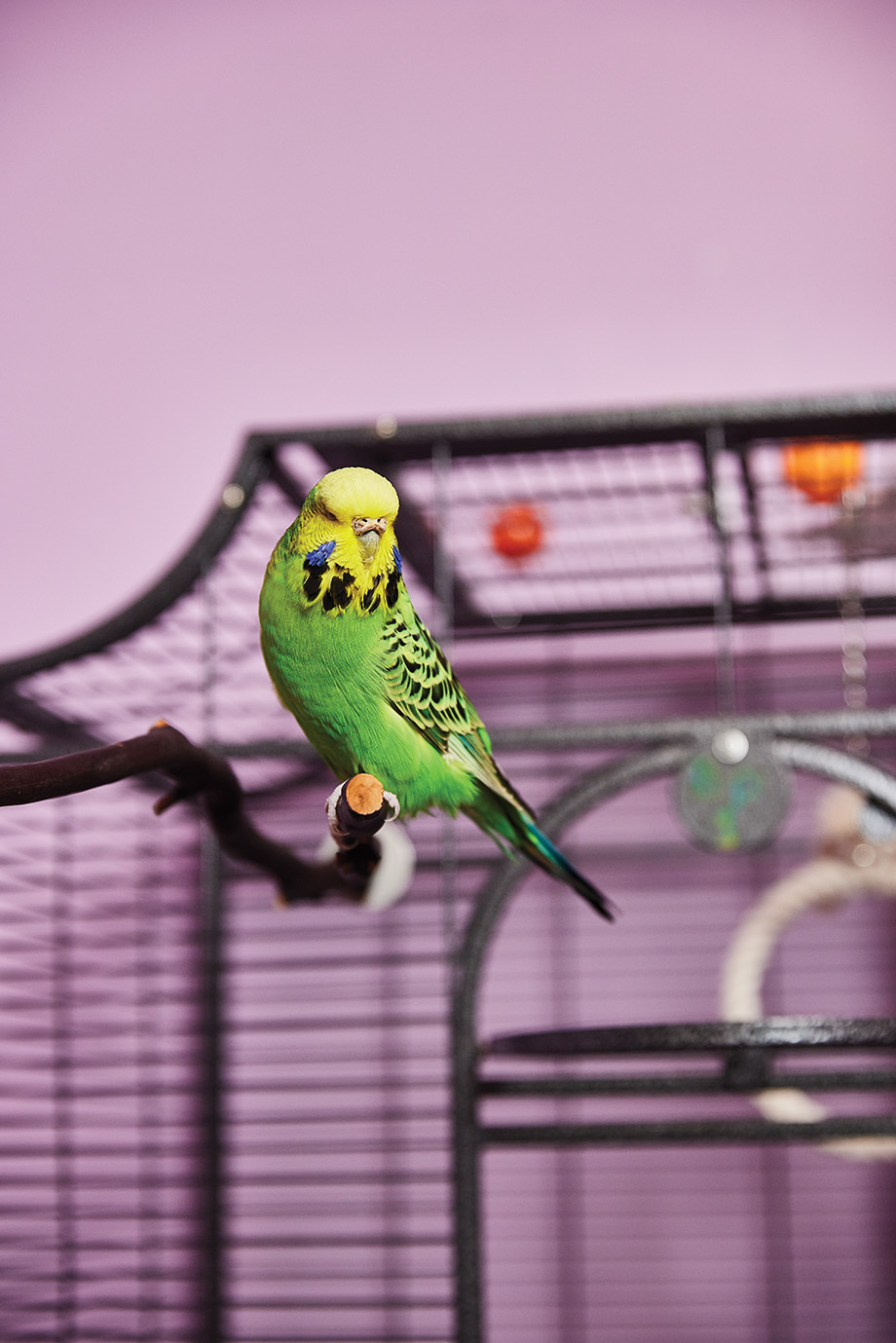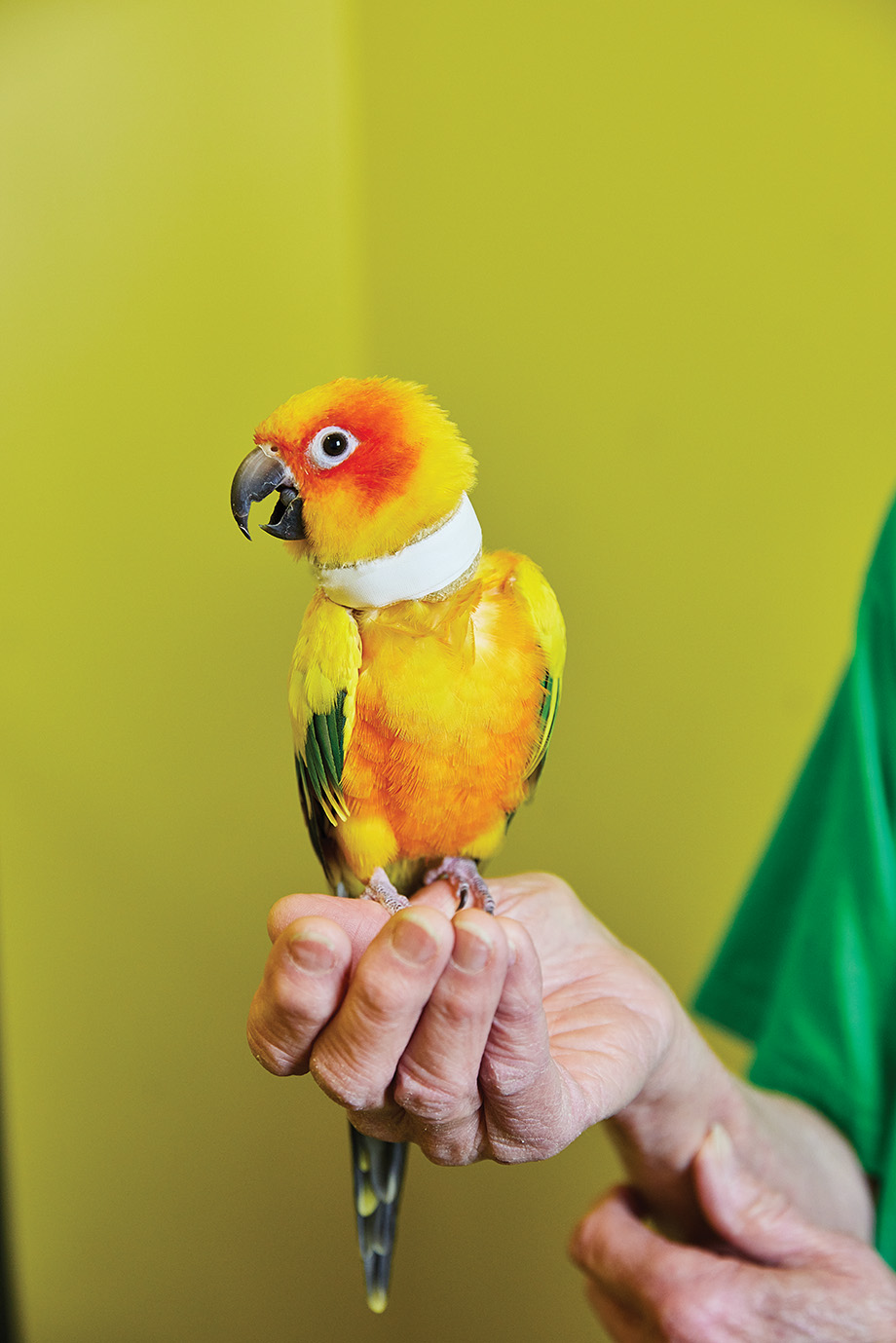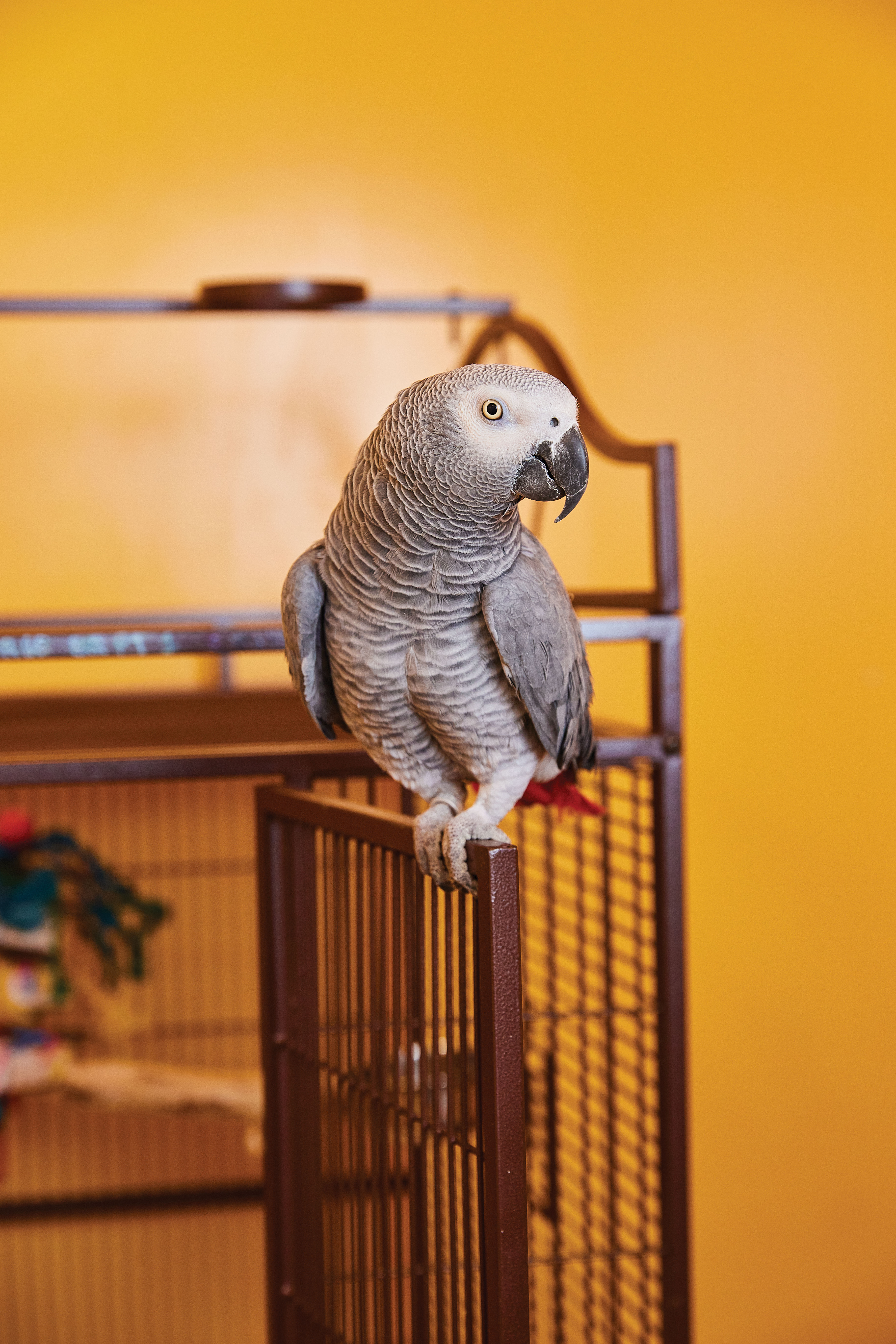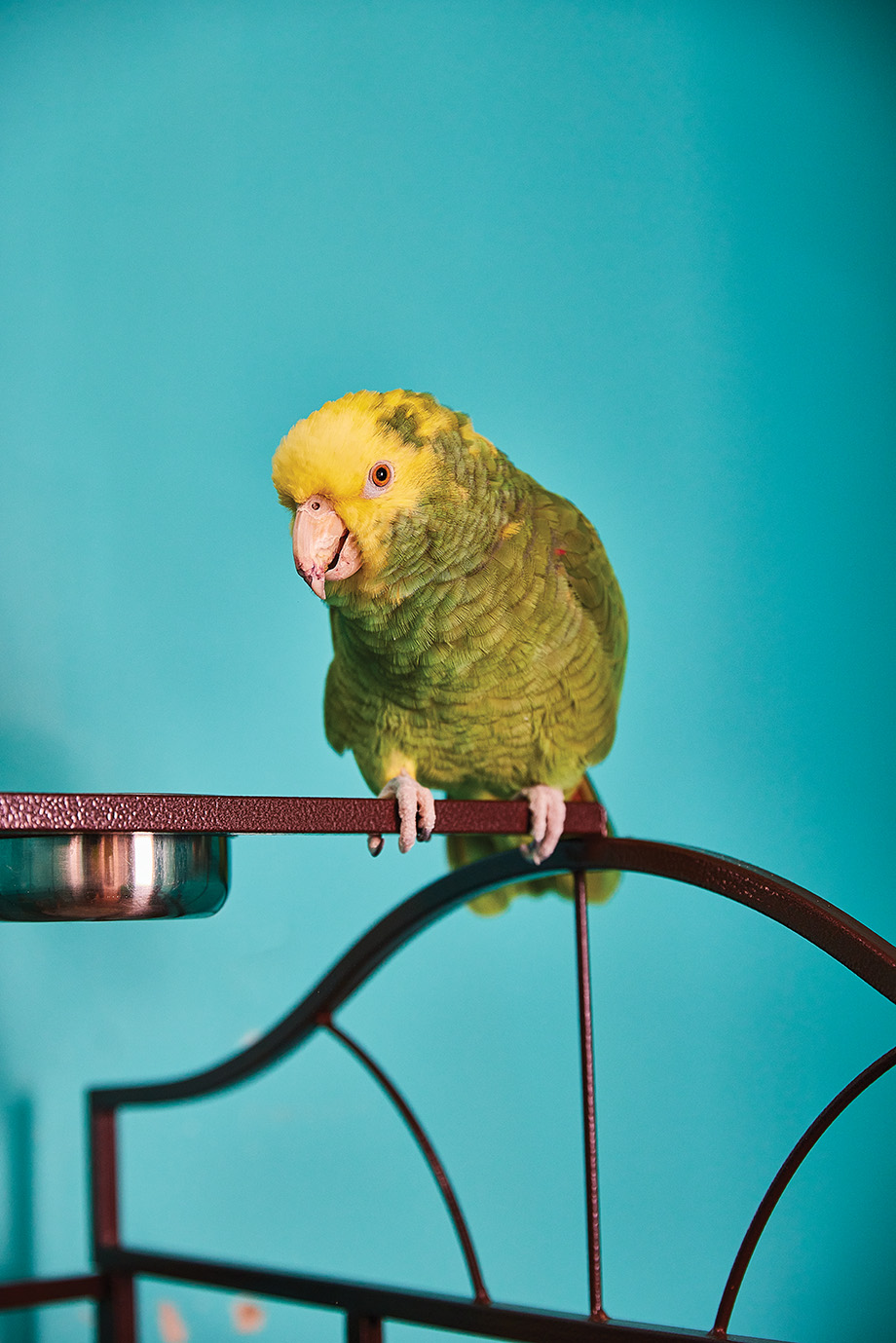
Pepper, a 5-year-old female English budgie. Photos: Chris Emeott
These companion animals are growing in popularity.
Sometimes, a bird picks you. That’s what happened to Metro area resident Karen Anderson on a day she least expected. It was 1994, and Anderson was a few years from an early retirement, visiting an exotic pet store in Burnsville with absolutely no intentions of buying a bird. She was chatting with a cluster of young cockatiels, when one singled her out.
“The one detached itself from the main flock and came over … I was there for a few minutes, and then I said, ‘Well, bird, I’ve got to go,’” she recalls. “And I started to walk away, and the bird just screeched and screeched and was running along on the inside of the [cage] after me.”
That’s when a pet store employee came over and opened the enclosure. “The little bird jumped out and ran up my arm and snuggled under my neck,” Anderson says. “And I thought, ‘Oh, man.’”
When she left the store, Anderson was $600 poorer and one white-faced cockatiel richer. The 10-week-old bird was later named Alfalfa for its protruding crest of head feathers. It was Anderson’s introduction into the world of parrots. But it wasn’t long until parrots became her world.
Nearly two decades later, Anderson lives alongside nine parrots and three canaries and is a staple in the Minnesota avian community. She now serves as president of the Minnesota Companion Bird Association (MCBA) and is the owner of Avian Suites, a Minneapolis avian boarding facility. One might consider her an expert at this stage, but it’s a title she will likely never accept.
“I’m not sure that in the world of companion birds there are experts,” she says. “Every time I turn around, I learn something new.”

Geronimo, an 18-year-old female sun conure (pronounced con-yer), is required to wear a collar due to extensive feather plucking, which can break the skin. The collar prevents her from reaching the trouble spot.
Finding a Flock
MCBA was founded in 1977 and is an educational, social and commercial network of more than 70 bird owners and professionals across the state and region. Meetings took place in Maple Grove prior to COVID-19 and now occur virtually, alongside informative events and occasional in-person conferences.
When Anderson became connected with MCBA as a part-time employee at Avian Suites, she says it “opened [her] whole world because you have all these people who otherwise look normal, who love their birds … It’s an interesting culture. There’s an old joke that says, ‘The only thing that the dog people and the cat people can agree on is that the bird people are crazy.’”
Regardless of, or perhaps due to, the unique characteristics of many bird lovers, Anderson has embraced it all, joining a growing group of Americans who own and love companion birds. A recent survey published in 2022 found that 8 percent of households have pet birds and almost half of new owners cite the pandemic as a factor in purchasing a companion bird.
“I don’t know that anybody has done any studies of why some of us are such freaks [about birds], but they’re very compelling. If you observe a bird or you sit with one and watch what they do, they are curious and they are funny … and there’s an intelligence or some sort of a spark in those bird eyes that lets you know there’s something going on back there, and that’s fascinating,” Anderson says.
While Anderson admits that not all people are bird people, she says those who are will find a spectacular companion in a pet bird.
“If I am not feeling particularly upbeat, I can go into my bird room and one of my grey parrots will ask, ‘Are you OK?’ They are empathic,” Anderson says.
For the millennials and Gen Zs that make up two-thirds of pet bird owners nationwide, some species have the potential to be lifelong companions. While many smaller parrots, such as parakeets, lorikeets and lovebirds, are likely to live for longer than 10 years, larger species like the African grey parrot, cockatoo or macaw can live more than 50 years.

Ajax, a 23-year-old male Congo African grey parrot.
Caring for Companion Birds
Lifespan is one of the many reasons why Anderson encourages potential bird owners to educate themselves and avoid impulse buying. Each species will suit a different lifestyle, age and budget—all important factors to consider as the disparity between the easier and what’s considered a more affordable bird is worlds from that of the expensive species that require more space, attention and stimulation. (An average macaw owner could spend $200 per month on toys alone just to keep the bird occupied, Anderson notes.)
Before jumping in, Anderson suggests that people ask themselves questions to gauge whether a pet companion is the right fit. Do I have time for this? Can I realistically care for this species for its entire lifespan? Do I have the funds to purchase a quality cage and setup for routine veterinary care and to feed it the vegetable-rich diet it requires? Where can I bring the bird when I need help or go out of town?
Pet birds and parrots (this includes parakeets, cockatoos, cockatiels and macaws), specifically, are very intelligent animals capable of speech, utilizing tools and reacting to situations. And it’s not just the large parrots that show the most character and aptitude. Even the smaller species, like the parakeet, are capable of speech. In fact, Puck, a parakeet from California, was recorded in 1995 to have retained an estimated 1,728 words.

Cleo, a female double yellow head Amazon parrot. She is estimated to be 20 years old.
In the right environment, parrots will thrive, play, learn and sometimes mimic or speak. And while the “right” environment varies depending on the species, birds who don’t have the diet, enrichment and space they need can become psychologically impaired and ill.
“Education is the biggest problem for people in the bird world because even people who think they know a lot of stuff get surprised. I was dumbfounded and then terrified when I found out what I didn’t know, and I spent 25 years trying to fix that,” Anderson says.
All that being said, Anderson hopes people are not dissuaded from owning a pet bird. Just like any animal, the rewards are bound to outweigh any challenges. Anderson encourages people with questions or who are looking for a fellow bird loving community to get involved and reach out to MCBA, Avian Suites or a parrot welfare organization.
“[Birds] are fantastic companions,” Anderson says. “A day does not go by that something [they do] does not make me laugh my fanny off.”
Debunking Bird Myths
Bird Myth #1
Birds are low-cost pets.
Even the smallest pet bird requires a great amount of attention and care, leading to greater expense—especially as you look into the bigger parrots. Each species has specific requirements for diet, enrichment toys and cage size. Bird professionals also recommend annual veterinary check-ups, which can be costly. Though a parakeet may be more affordable than a macaw, like any household pet, there is a cost to keep your companion bird happy and healthy.
Bird Myth #2
Birds are cuddly.
While ascribing human characteristics to animals is common, Anderson says it should be avoided with birds. “Birds are total aliens as related to us,” she says. “We’re mammals; they’re avian species. And we cannot possibly comprehend how they process things.” This feeds into the human propensity to cuddle animals, something many species of pet birds will not understand. Cockatiels are known to snuggle with their owners
and enjoy head and neck scratches, but too much physical touch can cause issues as they get older, Anderson says.
Bird Myth #3
Birds are loud.
Chirping, whistling, chiding and mimicry are normal for most pet birds, but consistent screeching and squawking is a cause for concern. Reacting to loud noises from a bird could reinforce the behavior, so it’s important to get informed about how to care for pet birds and meet their needs before purchasing one.
Bird Myth #4
Birds bite.
Birds use their beaks for more than just eating. While climbing and playing, a beak is an extra hand—and when a human finger is put out to “step up,” birds will often use their beaks to climb on. Jolting and shrieking in response to this can cause problems down the line, as they learn that grabbing causes an exciting reaction, Anderson says. While it’s likely any bird owner will get bit occasionally, consistent biting is a behavioral concern that should be remedied. Anderson suggests giving birds your whole hand to step on, so they see a safe platform rather than a precarious perch.
Minnesota Companion Bird Association
Facebook: Minnesota Companion Bird Association (MCBA)






















